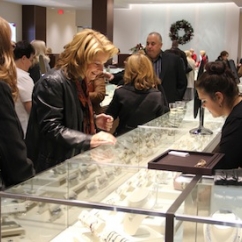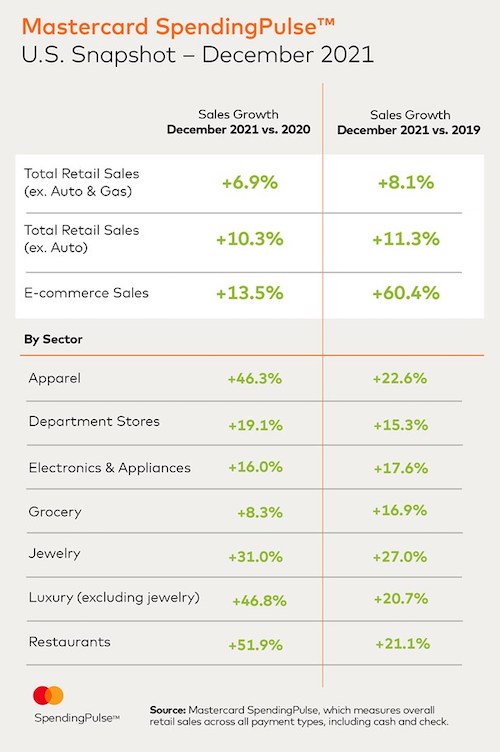Articles and News
Retail Trends For 2022: More Takeaways From Holiday 2021 | January 12, 2022 (0 comments)

Washington, DC—Fine jewelers had a stellar holiday season in 2021, as did most retailers in general, and consumers are entering 2022 in solid financial shape. But the holiday season did reveal some critical trends--such as BNPL--shaping how consumers shop and what retailers need to do to remain successful going forward. Image: shoppers at Borsheims in Omaha, NE, during a pre-COVID Berkshire Hathaway Shareholders event in the store.
Fine jewelry sales overall grew 31% year-on-year for the holiday season, while 75% of respondents to The Centurion’s holiday sales survey reported gains of at least 10% over 2020’s record figures, with a number saying their sales for the holiday leapt an astronomical 50% or 60%.
Figures from MasterCard SpendingPulse retail measurement service show an 8.5% gain in holiday retail sales overall, but the biggest increases in 2021 holiday gift spending came from jewelry, non-jewelry luxury, and apparel. Restaurants posted the biggest year-on-year gain in 2021—probably not surprising since many were operating in limited capacity last year—but among tangible goods, jewelry beat out both electronics and spending at department stores.
But what’s more telling is that fine jewelry did better than any other category, including restaurants, when comparing 2021 holiday sales to 2019, a better gauge of real category strength. SpendingPulse figures show jewelry sales increasing 27% for holiday 2021 vs. holiday 2019, lending further evidence of consumers’ changed priorities and preferences for lasting value.

E-commerce continues to rocket, jumping 13.5% YOY in December 2021 vs December 2020, and more than 60% over December 2019, according to SpendingPulse. This figure is especially worth noting because post-vaccine more consumers have been out and about and, interestingly, even more so in America’s least-vaccinated states.
But they’re still shopping online, which suggests it’s not only pandemic fears driving the online shopping increase. For the full 2021 holiday season, Mastercard says online sales grew 11% over 2020, which itself grew a staggering but unsurprising 61.4% over 2019. And for the full year 2021, 20.9% of all retail sales were online, vs. 14.6% of all retail sales in 2019.
With the holiday now solidly in the rearview mirror, SpendingPulse identified some key retail trends of the season that will grow in importance in 2022:
- Buying with a Purpose: Consumers are looking for retailers that share their values, creating and delivering products in a sustainable and inclusive way. Across the world, 85% of adults say they’re willing to take personal action to combat environmental and sustainability challenges. And 62% say it’s now more important that companies behave in sustainable and eco-friendly way.
- Commerce “E-volution”: Retailers and brands spent much of the pandemic shifting or expanding their digital channels, reflected in SpendingPulse figures for online sales. In 2022, innovation will be amplified with retailers looking at different platforms and tactics to reach hyper-connected consumers. "Online sales penetration was below 2020 levels for most categories, but significantly higher than 2019, suggesting the new normal is somewhere in between," the firm said.
- Experiential Retail: Retailers must think of their digital and physical stores more cohesively than distinctly separate channels. This trend led to “phygital” innovation in how retailers engage with customers digitally and in person. We expect the ability to make purchases “how I want” will continue, requiring retailers to offer hybrid models, says a Mastercard consumer impact study.
- Consumer Privacy Gets Real: The demand for personalized experience must be met by a heightened focus on consumer privacy. Retailers will need to find new ways to understand and engage their digital consumers effectively.
Here are some additional insights from holiday 2021 and retail trends to watch for 2022:
BNPL. The latest acronym to enter the retail lexicon, BNPL stands for “buy now pay later.” If you pay attention to no other retail trend, pay attention to this one. A best-of-both mashup of credit and layaway, it differs from standard credit financing in that it’s an interest-free installment payment option that, unlike layway, lets the customer have their item immediately through a partnership with a BNPL provider. This Philadelphia Inquirer article says it's a huge help to small retailers who are able to make sales they might not have done otherwise, especially to Millennials and Gen-Z consumers. This article in The Robin Report also says it's at a tipping point and soon will be essential for retailers (and direct-to-consumer brands) to offer it, and the Inquirer cites a 2021 study that found 60% of consumers already have used it or were planning to use it for the holidays. Some leading BNPL providers include Sezzle, Afterpay, Klarna, SplitIt, PayPal Credit, Zip, and Affirm.
The Robin Report also says retail cryptocurrencies are likely to be a dark horse retail trend of 2022. Retailers will eventually have to accept cryptocurrencies like Bitcoin, Ethereum, and Dogecoin, and some (like Amazon) will issue their own cryptocurrencies.
Earlier holiday shopping. This article in Retail Dive says Black Friday might no longer be a fair metric to measure holiday shopping. This year, Amazon’s Prime Day was in October, both Target and Walmart began holiday promotions in earnest in October, and there were fewer Black Friday promotions, which might be the start of a reframing of the holiday shopping season.
Consumers are in good financial shape. Despite doom-and-gloom reports about inflation, the supply chain, and worker shortages, consumers are able and willing to spend, says the Retail Dive article. And Jamie Dimon, CEO of JPMorgan Chase, the country’s largest financial institution, told CNBC, “We’re going to have the best growth we’ve ever had this year, I think since maybe sometime after the Great Depression. Next year will be pretty good too.”
Dimon’s confidence stems from the robust balance sheet of the American consumer, says CNBC. JPMorgan has relationships with half of the country’s households, and Dimon says consumers’ balance sheets have never been in better shape. “They’re spending 25% more today than pre-Covid. Their debt-service ratio is better than it’s been since we’ve been keeping records for 50 years.”
Federal Reserve Chair Jerome Powell said the same thing in December. “Fundamentally, the consumer is really healthy.” And Wall Street largely shrugged off the January 12 inflation report, with stocks climbing higher that day regardless.
Post-holiday spending and returns extend the season. Retail Dive says though the holiday season has ended, consumers' spending hasn't. More than half (51%) of shoppers said they plan to shop after Christmas, with 38% planning to return gifts this year, according to a RetailMeNot survey of more than 1,000 consumers. Many brands and retailers have generous holiday return policies and/or have extended their holiday returns period until mid-to-late January. The RetailMeNot survey says 34% of respondents are shopping for themselves after the holiday season ends.
Gen-Z is flexing its muscle. This cohort, now entering adulthood has gained purchasing power and is playing a larger role as tastemakers, says Retail Dive. They’re also more likely to purchase through social media platforms and via an app than older generations, leading retailers to focus on targeting ads to them that way.







